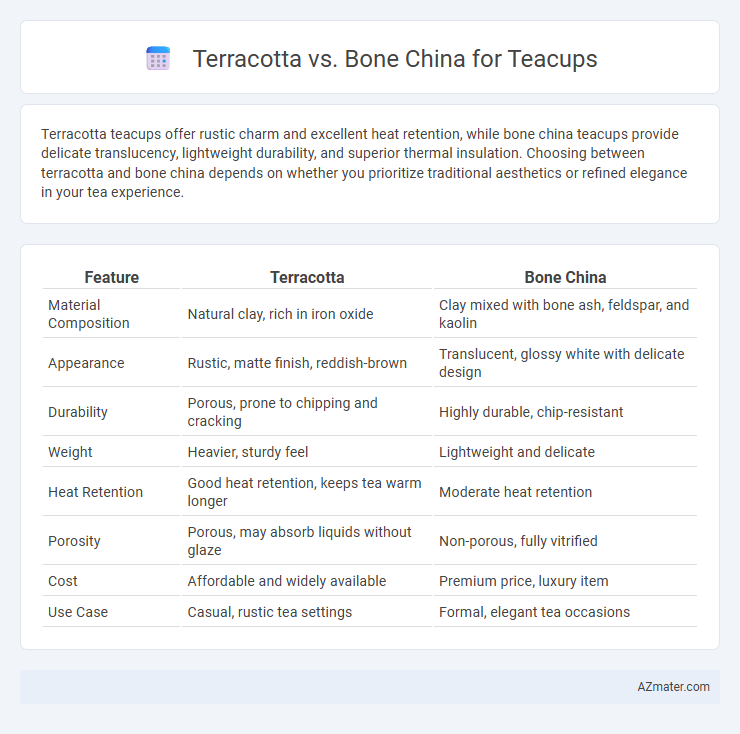Terracotta teacups offer rustic charm and excellent heat retention, while bone china teacups provide delicate translucency, lightweight durability, and superior thermal insulation. Choosing between terracotta and bone china depends on whether you prioritize traditional aesthetics or refined elegance in your tea experience.
Table of Comparison
| Feature | Terracotta | Bone China |
|---|---|---|
| Material Composition | Natural clay, rich in iron oxide | Clay mixed with bone ash, feldspar, and kaolin |
| Appearance | Rustic, matte finish, reddish-brown | Translucent, glossy white with delicate design |
| Durability | Porous, prone to chipping and cracking | Highly durable, chip-resistant |
| Weight | Heavier, sturdy feel | Lightweight and delicate |
| Heat Retention | Good heat retention, keeps tea warm longer | Moderate heat retention |
| Porosity | Porous, may absorb liquids without glaze | Non-porous, fully vitrified |
| Cost | Affordable and widely available | Premium price, luxury item |
| Use Case | Casual, rustic tea settings | Formal, elegant tea occasions |
Terracotta vs Bone China: An Introduction
Terracotta teacups offer a rustic, earthy aesthetic with porous properties that enhance the flavor profile of brewed tea, making them ideal for traditional tea experiences. Bone china teacups feature a refined, translucent quality and exceptional durability due to their high bone ash content, providing elegance and resilience. Understanding the distinct materials and production methods highlights the contrasting benefits of terracotta's natural texture versus bone china's delicate craftsmanship.
Composition and Material Differences
Terracotta teacups are made from porous, unglazed clay that offers a rustic texture and excellent heat retention but can absorb liquids if not properly glazed. Bone china consists of refined clay mixed with bone ash, resulting in a lightweight, durable, and translucent material known for its strength and delicate appearance. The high calcium phosphate content in bone china differentiates it from terracotta, providing superior whiteness and chip resistance ideal for fine teaware.
Aesthetic and Visual Appeal
Terracotta teacups offer a rustic, earthy aesthetic characterized by their warm, natural hues and textured surfaces that evoke traditional craftsmanship. Bone china teacups, renowned for their translucency and pristine white finish, present a refined, elegant look with delicate patterns often enhanced by fine gilding. The visual appeal of terracotta lies in its organic simplicity, while bone china captivates with its smooth, glossy surface and sophisticated design details.
Durability and Strength Comparison
Terracotta teacups are porous and more prone to chipping or cracking due to their lower firing temperatures, resulting in moderate durability. Bone china teacups boast higher strength and durability, attributed to their composition of bone ash and higher firing temperature, making them resistant to impacts and long-lasting. The dense, non-porous structure of bone china ensures superior resilience compared to the more fragile, earthenware nature of terracotta.
Heat Retention and Temperature Control
Terracotta teacups excel in heat retention due to their porous structure, allowing them to maintain warmth longer without becoming excessively hot to the touch. Bone china, while elegant and lightweight, dissipates heat more quickly, providing better temperature control for drinking but shorter heat retention. Choosing between terracotta and bone china depends on whether extended warmth or precise temperature regulation during use is preferred.
Porosity and Flavor Impact
Terracotta teacups exhibit higher porosity compared to bone china, allowing for greater absorption of tea flavors and subtle changes over time, which can enhance the complexity of each brew. Bone china, with its dense and non-porous structure, preserves the original flavor by preventing absorption, ensuring a clean and consistent taste with every cup. The choice between terracotta and bone china significantly influences the depth of flavor and sensory experience during tea consumption.
Weight and Handling Experience
Terracotta teacups are notably heavier and offer a solid, earthy feel that appeals to those who prefer a substantial grip during tea drinking, enhancing stability and warmth retention. Bone china teacups are significantly lighter, providing a delicate and smooth hand feel that emphasizes elegance and refinement, making them ideal for refined settings and long sipping sessions. The weight difference impacts handling comfort, with terracotta favoring durability and rustic charm, while bone china prioritizes lightweight sophistication and tactile delicacy.
Maintenance and Cleaning Requirements
Terracotta teacups require gentle hand washing with mild soap to prevent absorption and cracking due to their porous nature, while avoiding prolonged soaking to maintain durability. Bone china teacups offer easier maintenance with their non-porous, vitrified surface, allowing dishwasher cleaning without risk of damage or staining. Both materials need careful handling to avoid chipping, but bone china's smooth glaze ensures residue-free cleaning and less frequent deep maintenance.
Sustainability and Environmental Considerations
Terracotta teacups offer superior sustainability due to their natural clay composition, requiring lower energy for firing and producing minimal waste compared to bone china, which relies on bone ash and intensive manufacturing processes. Bone china's production involves more resource consumption, including animal-derived materials and higher emissions, impacting its environmental footprint negatively. Choosing terracotta supports eco-friendly practices through biodegradability and reduced carbon emissions in the lifecycle of the teacup.
Choosing the Best Teacup for You
Terracotta teacups offer a rustic charm with excellent heat retention, ideal for those who enjoy a natural, earthy aesthetic and a warm tea experience. Bone china teacups provide a delicate, lightweight feel with superior translucency and strength, perfect for elegant settings and refined tea drinking. Selecting the best teacup depends on your preference for durability versus elegance and whether you prioritize thermal insulation or a sophisticated design.

Infographic: Terracotta vs Bone China for Teacup
 azmater.com
azmater.com